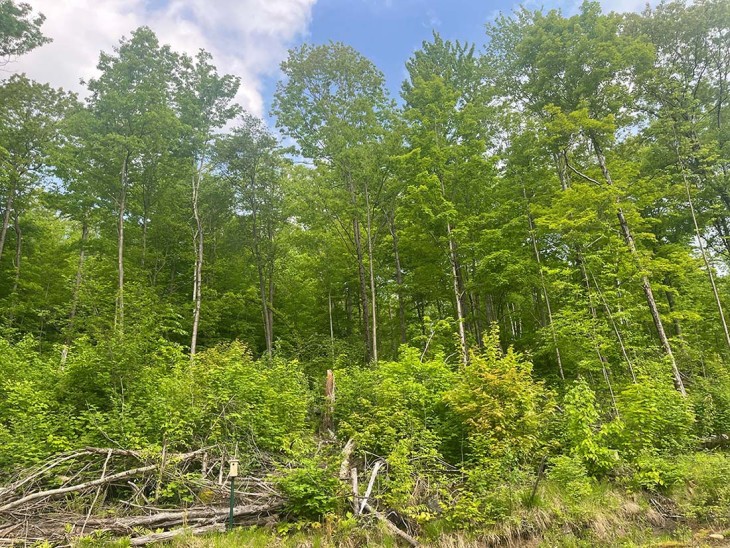
I’ve heard foresters and wildlife biologists talking about “softening edges.” What is an edge, and what does it mean to “soften” one? Why is it important? And how do we do it?
In our ecosystems, “edges” are ecotones: the places where two distinct environments come together, creating a diverse mix of habitats for a range of wildlife species. Natural edges include where wetlands meet forests, where young forests meet older forests, and along the margins of gap or group openings within forests. In terms of sheer number of species, these ecotones tend to foster some of the highest levels of diversity within ecosystems – from trees, shrubs, and plants to pollinators and other invertebrates, mammals, birds, and more. While these natural edges are rich and important habitats, they aren’t what we’re referring to when we talk about softening edges.
In most of New England, we have an abundance of “unnatural” edges – places where forests meet fields, yards, and other cleared and built environments. While these edges can provide some good habitat, we don’t need any more of them. What we really need is more protected, unfragmented interior habitat – in other words, large blocks of forest, unbroken by roads and houses. That said, “softening” edges is a way to enrich the edge habitat that we have, making it a greater resource for our biodiversity.
Softening edges means that, instead of having fields or yards that transition abruptly into forests of tall trees, we manage for a fringe of vegetation where grasses transition into plants, shrubs, and small trees before meeting the full-sized trees of the forest. Soft edges enrich our unnatural edges, providing habitat for wildlife species that require shrublands and young forest for part or all of their life cycle.
Often the best and easiest way to soften field or yard edges is to simply allow soft edges to establish themselves. Rather than mowing or brush-hogging right up to the treeline, leave a wide (as wide as you can) un-mowed strip for a few years and see what happens. Most likely, what you will observe over time is the gradual transition of grasses to herbaceous plants, to pioneer species such as Spirea (steeplebush, meadowsweet), to shrubs including willows, dogwoods, and Viburnums and some tree species such as gray birch, aspen, and white pine.
If you don’t have the space to allow edges to claim your field or yard, you can push the edge into the woods – cutting some trees on the edge of your forest and allowing the area to naturally regenerate. The trees you cut can be used for firewood, or they can be left on the ground; leaving some dead wood within that edge habitat will provide improved cover and foraging opportunities for birds and other wildlife. Once it regenerates, you can maintain this edge (and edges created by not mowing, as described above) simply by cutting young trees when they get too tall, and doing what you can to encourage small tree and shrub species over full-sized tree species. If you establish an edge by cutting trees, remember that interior habitat is less common and more ecologically precious than edges, so be conservative – it’s not worth sacrificing a large area of healthy forest to create a large edge.
As many Northern Woodlands readers know, edges often invite non-native invasive plants such as buckthorn and honeysuckle. Non-native invasives tend to thrive in edges, diminishing both the habitat offered by these edges and, eventually, the habitat of surrounding ecosystems as the invasives invariably work their way deeper into the woods. A vital part of creating and maintaining edge habitat is walking the edges – especially during late summer and early autumn, when invasives are most visible – looking for these invasive plants and removing them at the first sighting. If you catch them when they’re small, you can pull invasives by hand. If you allow them to get larger, you might need to use a strategy such as cut-stump treatment (see Forest Insights in the Spring 2022 issue of Northern Woodlands).
If you’re not getting the mix of species you were hoping for through natural regeneration, you can inject your edges with a little more diversity by doing some enrichment planting. My favorite species to plant on edges are shrubs in the genus Viburnum (nannyberry, highbush cranberry, arrowwood), dogwoods (red osier, silky, roundleaf, greystem), and shrub willow – all species that provide important food and cover for insects, birds, and mammals while staying relatively small.
Softening edges is a great way to enrich the habitat we have, supporting increased diversity on the thresholds between our built and natural environments. If you have an edge, you might as well make it a soft edge!

